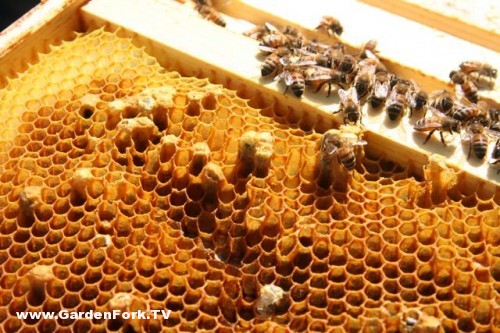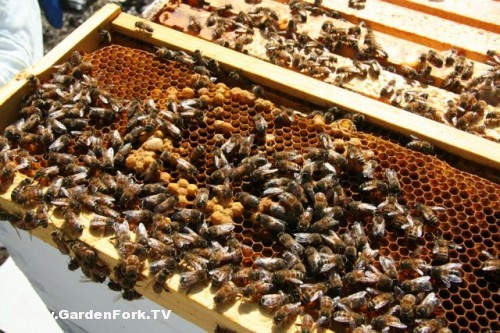When we check our honeybee hives, we first just stand there and observe them. We could tell there was something wrong with one of the hives.

note the large drone cells scattered about
It was quiet, the hive next to it was buzzing with activity.
We opened it up to hear this odd low frequency hum in the hive, not something you usually hear. One look at a brood frame told us we had a bad problem on our hands.
The queen was dead.
And to make matters worse, one or more workers had started laying eggs in the cells, and since workers are infertile, all the eggs are drones.

Queenless hive, signs of the drone laying worker here
So how can a worker bee lay eggs? If a hive is queenless, her pheromone is absent, and a few of the workers can then begin lay eggs. It doesn't happen everytime a hive loses queen, and this is the first time it has happened to us.
You can't just put new queen in one of these hives, as the laying workers will kill the new queen. You have two choices, either combine the queenless hive with a healthy hive nearby, or get rid of the laying workers.
One of our Facebook fans explained how she did this:
Rhonda wrote: "Not good. I had this happen last year. I took the hive that had some young bees and some older bees in it and moved at about 2000' away from the original location, dumped all the bees out onto the ground-every one of them, then took the hive body back to the original location. The younger, drone layers had not been out of the hive yet, so they could not find their way back home. I then transferred a queen cell from another hive into that hive and before long everything was good again. I know, it as a bit chancy, but the other options weren't much better."

Healthy frame of brood, note the curled up larvae.
The laying workers are nurse bees who have yet to leave the hive, so they have don't know any outdoor landmarks or orientation to return to the hive. The older bees, who are foragers, know the location of the hive, so when dumped out of the hive, they will fly back to its location.
This hive was pretty weak, so I'm thinking right now i'll combine it with the stronger hive next to it, and perhaps split the strong hive in week or two, with a new queen in the split. * we did the beehive combine, click here to see how to combine beehives
Have you dealt with a drone laying worker? Let us know below

Tonia Moxley
In reading Sue Hubbell's "Book of Bees" -- a literary how-to book/memoir on beekeeping. She used to live in the Ozarks and run a 300-hive honey farm. She now lives in Maine and is a full-time science writer.
Anyway, she outlines in "Book of Bees" what she does with laying worker hives. She makes up a nuc (or you could buy one) and while the foragers are out during the day puts that in place of the troubled hive. The full foragers come back to the nuc, and mostly are let in (although some are killed by guard bees, she said). Then, she does a newspaper combine with some of the workers in the old hive.
I guess she pinches the old queen, if she's not dead already. She said it normally works and is quick and easy to do.
Hope that helps.
T.
Jay Willis
We had the same thing happen this year with a hive with two deep brood chambers. We all of the classic symptoms; multiple eggs in each cell, eggs on the sides of cells, bullet shaped capped worker cells, large drone population, etc.
I didn't want to combine the hives so I took the advice of a very wise, seasoned beekeeper. He contends that it's the lack of pheromones from open WORKER brood that allows the worker bee's ovaries to develop. He advised us to knock the bad hive down to one body first. Then, we put it directly on top of a good hive with a screen between the two. We sprayed this screen with sugar water which encouraged the two hives of bees to interact and assist in transfer of the open worker brood pheromones between the good hive and bad. We left the hive cover on the bad hive cracked slightly so the bees from the bad hive could enter/exit on the side opposite of the good hive. After a week, we examined the bad hive and found only clean empty cells.
We then swapped a couple of frames with emerging brood from the good hive into the center of the bad hive and placed a caged queen between them. Three days later, we released her and came back a week later. Now we have beautiful laying patterns and it looks like that hive is on it's way back to being productive.
Hope this helps. It worked wonders for us. By the way, he said shaking the bees out doesn't always work because there is no guarantee that the laying workers aren't older bees that haven't been out of the hive before and know their way back. Although unlikely, he said that older laying worker may return to the hive and kill a new queen.
andrea
May I ask if you know if this happens in the wild?
(I am still new here -so I apologize if this is a Naive question)
Thank you.
andrea
don't know how to delete my comment..I will just research some things..
I rally am just very interested what changesbees go through if "kept" (beekeeping)
differences from wild nests etc (but this is not what your site is about--
Please know I am very sorry---and I hope you will delete this .
and..no more from me. (from now on- just here to learn)
andrea
Eric
at this point, I think bees are a domestic animal. Its very hard for feral bees to survive winter in the Northern states. Best to join the Backyard Beekeepers of CT and take their classes. So many new beekpeepers don't take a class and kill their bees. http://backyardbeekeepers.com/wp/